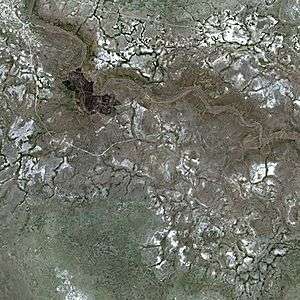Lake Makgadikgadi


Lake Makgadikgadi is an ancient lake that existed in what is now the Kalahari Desert in Botswana. It may have once covered as much as 80,000 km² and was 30 m deep. The Okavango, Zambezi, and Cuando rivers once all emptied into the lake.
Origin and history
Approximately 3 million years ago, strong easterly winds brought about the formation of elongated dunes which ran from east to west across the middle of the Kalahari Desert. During wetter times, these dunes channeled the flow of the great rivers of the area, the Okavango, Chobe, and Zambezi, eastwards with the Limpopo River into the Indian Ocean.
Approximately 2 million years ago, the formation of the fault known as the Kalahari-Zimbabwe axis, which runs from the Zimbabwe capital Harare through its second-largest city Bulawayo and ends in the eastern side of the Kalahari, created an enormous basin and forced these rivers to flow into and fill up the basin. Lake Makgadikgadi was thus created.
As the millennia passed, the lake was filled to capacity and began to overflow. About 20,000 years ago, as a result, it began to drain northwards and then eastwards. This caused the middle and lower Zambezi Rivers to connect, resulting in the formation of Victoria Falls. With the water now able to flow out of the basin, Lake Makgadikgadi was able to drain partially and its average level decreased.
A drier climatic period followed which caused an increase in evaporation and a decrease in the flow of the rivers that fed it. By about 10,000 years ago the drying of Lake Makgadikgadi was in an advanced stage. Sediment and debris from the Okavango River and windblown sand were gradually filling the lake.
The formation of the Gumare fault lowered the land. As a result, the water of the Okavango River spread out over a much larger area of land than it previously did, forming the now characteristic fan-shaped inland delta of the Okavango, which further reduced the water that flowed into Lake Makgadikgadi and hastened its demise.
Today the only remains of Lake Makgadikgadi are the Okavango Delta, the Nxai Pan, Lake Ngami, Lake Xau, the Mababe Depression, and the two main Makgadikgadi pans of Sua and Nwetwe.
Ecology
Lake Makgadikgadi is theorized to have been the birthplace of the vast number of cichlids[1] that once swam the Congo River, Zambezi River, Okavango River and Limpopo River - as many as 100 to 400 new species, of which approximately 25 survive today. The lake's sheer size may have provided the ancestors of these fish with an extremely wide range of new ecological niches to exploit and thus could have served as the stimulus for the evolution of the new species, which they may have done in record time before the lake drained completely. The theory further says that the new species, after having evolved within the confines of the lake, could have escaped with the lakewater as it drained, and populated the rivers of the region to evolve into the cichlids that exist today.
In current times this land is desiccated most of the year and is a seasonal wetland in the rainy summer months.[2]
References
- C. Michael Hogan (2008) Makgadikgadi, The Megalithic Portal, ed. A. Burnham
- James Owen (May 4. 2005) Lost African Lake Spawned Fish Diversity "Beyond Belief. National Geographic News
Line notes
External links
| Wikimedia Commons has media related to Lake Makgadikgadi. |
Coordinates: 20°43′0″S 24°57′3″E / 20.71667°S 24.95083°E